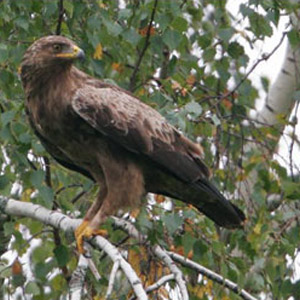Pratique | Identification
Les Aigles pomarin et criard en Estonie, et l’identification des hybrides

Aigle pomarin (Aquila pomarina) en Estonie.
Photographie : Urmas Sellis / « Eagle and Black Stork in Estonia »
Introduction
L’Estonie est le pays balte le plus septentrional. Son territoire est couvert en grande partie de forêts, de prairies et de plans d’eau, ce qui le rend très attractif pour une grande variété de rapaces diurnes et nocturnes.
Si la situation de la plupart des espèces est bonne, ce n’est pas le cas pour l’Aigle criard, dont le nombre de couples ne dépasse pas 20. L’Aigle pomarin est plus commun, avec 500 couples environ.
Plusieurs menaces pèsent sur ces deux oiseaux, comme la destruction des sites de nidification, les dérangements et la dégradation des zones d’alimentation.
Le projet EagleLife « Conserving eagle and black stork populations in Estonia », soutenu par la Commission Européenne, avait pour but d’améliorer leur situation, mais aussi celle de la Cigogne noire, et de sensibiliser le public.
Après une présentation de la situation des deux rapaces en Estonie, nous décrivons le projet EagleLife et ses résultats, nous nous attardons sur le phénomène de l’ybridation, qui pourrait constituer un problème sérieux pour l’Aigle criard, et nous terminons par une interview d’Urmas Sellis, de la Société Ornithologique d’Estonie (Eesti Ornitoloogiaühing), qui a piloté le projet.
Abstract
Estonia is a state in the Baltic Region in Northern Europe. It is bordered to the North by the Gulf of Finland, to the West by the Baltic Sea, to the South by Latvia and to the East by the Russian Federation. The country is covered with forests, wetlands and lakes and grasslands.
Since the situation for most Estonian eagles is good, then unfortunately the Greater Spotted Eagle and Black Stork can be expected to disappear in the face of a variety of dangers. The Lesser Spotted Eagle population is estimated to be between 500-600 pair, with Greater Spotted Eagles as few as 20 pairs. The Black Stork population is believed to be a maximum of 80 pairs. The eagles and black stork populations are endangered mostly by the destruction of nesting grounds in the course of forest cutting, disturbances during nesting season and the deteriorating quality of feeding grounds.
The EAGLELIFE project « Conserving eagle and black stork populations in Estonia », supported by the European Commission, adopted a nationwide approach to improving the conservation of these three species.
After a presentation of the situation of both eagles in Estonia, we describe the project and its results, we speak about the phenomenon of hybridization between the two eagles in Estonia, which is a significant threat for the Greater Spotted Eagle, and then we propose you an interview of Urmas Sellis, member of the Estonian Ornithological Society which leaded the EagleLife project.
Poursuivez la lecture de cet article, en vous abonnant dès maintenant !
Découvrez les Archives d’Ornithomedia.com
Pour seulement 10,00 €TTC/an (ou 6,00 € les 6 mois)
Profitez de plusieurs centaines d’articles en accès illimité et sans aucun engagement.
Compléments
À lire sur le web
Le site web de la Société Ornithologique d’Estonie (Eesti Ornitoloogiaühing) : www.eoy.ee
Ouvrages recommandés
- Le guide Ornitho de Killian Mullarney
- Carte Estonia 2007
- Guide des rapaces diurnes du monde de David-A Christie et al
Sources
- Urmas Sellis (2009). Arrangement of Spotted eagles and Black Stork conservation in Estonia. Eesti Ornitoloogiaühing. http://ec.europa.eu
- Jan Lontkowski et Grzegorz Maciorowski (2010). Identification of juvenile Greater Spotted Eagle, Lesser Spotted Eagle and hybrids. Dutch Birding. 32. Pages 384-397
- Fred Jûssi, Tiit Randla, Urmass Sellis, Ulo Vâli (2009). Kotkaklubi. MTÜ. LIFE-Nature project. http://www.kotkas.ee/failid/Kotkad_ENG.pdf
- VALI Ülo, DOMBROVSKI Valery, TREINYS Rimgaudas, BERGMANIS Ugis, DAROCZI Szilárd J., DRAVECKY Miroslav, IVANOVSKI Vladimir, LONTKOWSKI Jan, MACIOROWSKI Grzegorz, MEYBURG Bernd-Ulrich,
- MIZERA Tadeusz, ZEITZ Róbert et ELLEGREN Hans (2010). Widespread hybridization between the Greater Spotted Eagle Aquila clanga and the Lesser Spotted Eagle Aquila pomarina (Aves: Accipitriformes) in Europe. Biological Journal of the Linnean Society. Vol. 100, numéro 3, pages 725-734.




Aucun commentaire sur ce sujet
Participer à la discussion !